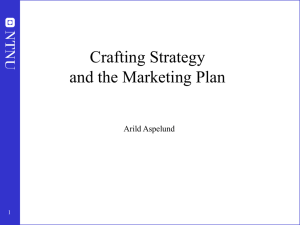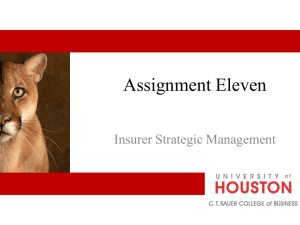Module 7 Module 7 Types of organizational strategies Types of
advertisement
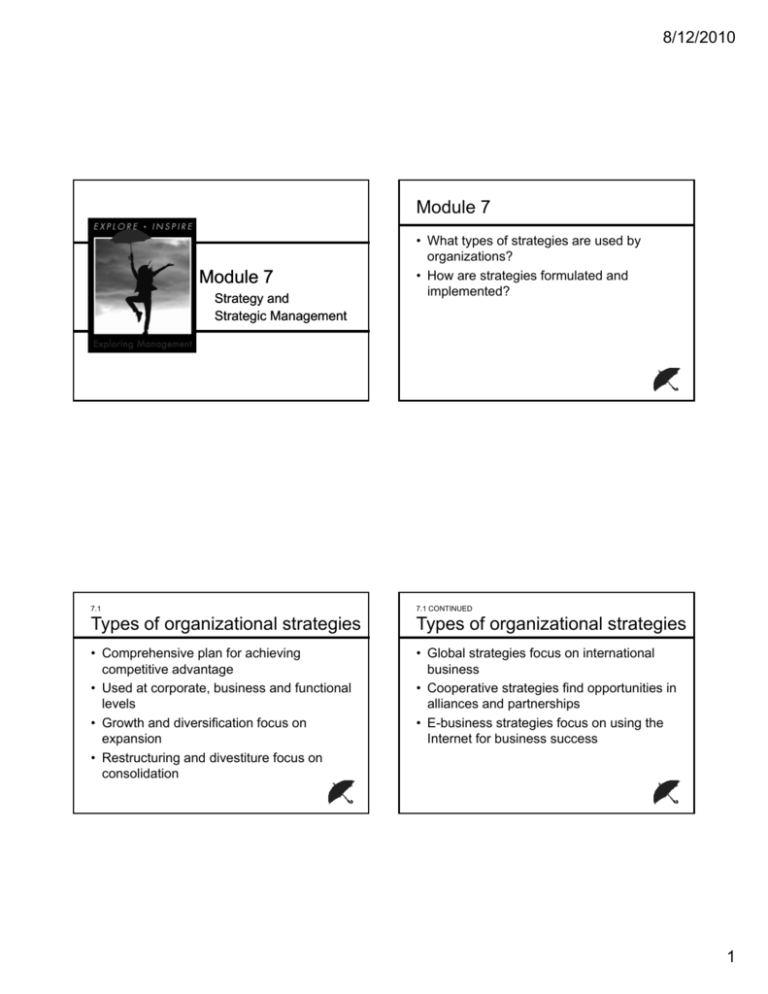
8/12/2010 Module 7 Module 7 Strategy and Strategic Management • What types of strategies are used by organizations? • How are strategies formulated and implemented? 7.1 7.1 CONTINUED Types of organizational strategies Types of organizational strategies • Comprehensive plan for achieving competitive advantage • Used at corporate, business and functional levels • Growth and diversification focus on expansion • Restructuring and divestiture focus on consolidation • Global strategies focus on international business • Cooperative strategies find opportunities in alliances and partnerships • E-business strategies focus on using the Internet for business success 1 8/12/2010 TYPES OF STRATEGIES TYPES OF STRATEGIES Competitive Advantage Corporate Strategy • Strategy – a comprehensive plan guiding resource allocation to achieve long-term organization g goals. • Strategic Intent – focuses organizational energies on achieving a compelling goal. • Competitive Advantage – operating in successful ways that are difficult to duplicate. • Corporate Strategy TYPES OF STRATEGIES TYPES OF STRATEGIES Corporate Strategy Growth and Diversification Strategies – Directions and guidelines for use of resources • Business Strategy – Identifies how a strategic g business unit or division will compete in its product or service domain • Functional Strategy – Guides activities within one specific area of operations • Growth Strategy – Expansion through current operations • Concentration – Expansion p within an existing g business area • Diversification – Expansion occurs by entering new business areas • Vertical Integration – Expansion by acquiring existing suppliers or distributors 2 8/12/2010 TYPES OF STRATEGIES TYPES OF STRATEGIES Restructuring and Divestiture Global Strategies • Retrenchment • Globalization Strategy – Changes operations to correct weaknesses – Liquidation • An extreme form of retrenchment wherein the business closes and sells off its assets • Restructuring Restr ct ring – Reduces the scale or mix of operations • Downsizing – Decreases the size of operations • Divestiture – Sells off part of the organization to focus on core businesses – Adopts standardized products and advertising for use worldwide • Multidomestic Strategy – Customizes advertising and products to best fit local needs • Transnational Strategy – Seeks efficiencies of global operations with attention to local markets TYPES OF STRATEGIES TYPES OF STRATEGIES Cooperative Strategies E-business • Strategic Alliances • E-business Strategies – Partnership between organizations to pursue mutual interests or strengthen competitive advantage • Supply Chain – Preferred relationships that facilitate smooth and timely transactions • Co-opetition – Competitors share information or technology – Focus on Using the Internet for Business Transactions • B2B Business Strategies – Use IT and Web portals to vertically link organizations with members of their supply chains. • B2C Business Strategies – Use IT and Web portals to vertically link organizations with members of their customers. 3 8/12/2010 7.2 7.2 continued Strategic Management Strategic Management • The strategic management process formulates and implements strategies. • Strategy formulation begins with the organization’s mission and objectives. • SWOT analysis l i identifies id tifi strengths, t th weaknesses, k opportunities, and threats. • Porter’s five forces model examines industry attractiveness. • Porter’s competitive strategies model examines business or product strategies. • Portfolio planning examines strategies across multiple businesses or products. • Strategic St t i leadership l d hi activates ti t organizations i ti ffor strategy implementation. STRATEGIC MANAGEMENT STRATEGIC MANAGEMENT Strategic Management Process Strategic Management Process • Strategic management – the process of formulating and implementing strategies. • Strategy Formulation – the process of creating strategies. • Strategy Implementation – the process of putting strategies into action. 4 8/12/2010 STRATEGIC MANAGEMENT STRATEGIC MANAGEMENT Strategy Formulation Strategy Formulation • Mission Statement Common Operating Objectives of Organizations • Profitability • Market share • High-quality workforce • Cost efficiency efficienc • Product and service quality • Innovativeness • Social responsibility – The reason for the organizations existence in society • Operating Objectives – Specific results that organizations attempt to achieve STRATEGIC MANAGEMENT STRATEGIC MANAGEMENT SWOT Analysis SWOT Analysis • SWOT analysis is a tool used in strategic planning to determine the current status of the organization. – Internal assessment of the organizational strengths and weaknesses – External assessment of environmental opportunities and threats 5 8/12/2010 STRATEGIC MANAGEMENT STRATEGIC MANAGEMENT SWOT Analysis Porter’s Five Forces • Core Competency – A special strength that gives an organization a competitive advantage STRATEGIC MANAGEMENT STRATEGIC MANAGEMENT Porter’s Five Forces Porter’s Competitive Strategies • Unattractive industry Porter’s Competitive Strategies • Differentiation Strategy – intense rivalry, easy entry, substitute products, powerful suppliers and customers • Attractive industry – low rivalry, barriers to entry, few or no substitute products, weak supplier and customer power – Offers products and services that are uniquely different from the competition. • Focused Differentiation Strategy gy – offers a unique product to a special market segment. • Cost Leadership Strategy – Seeks to operate at lower costs than competitors. • Focused Cost Leadership Strategy – uses cost leadership and target needs of a special market. 6 8/12/2010 STRATEGIC MANAGEMENT STRATEGIC MANAGEMENT Porter’s Competitive Strategies Portfolio Planning • BCG Matrix – Analyzes business opportunities according to growth rate and market share STRATEGIC MANAGEMENT STRATEGIC MANAGEMENT Strategic Leadership Strategic Leadership • Strategic Leadership • Strategic Control – The capability to inspire people to successfully engage in a process of continuous change, g , performance p enhancement, and implementation of organizational strategies. – Responsibility of management to stay on top of strategy, how it’s being implemented and if it needs to be adjusted j to be more effective in accomplishing the mission. 7 8/12/2010 Module 7 Case • Case Snapshot - Dunkin’ Donuts: Betting Dollars on Donuts 8
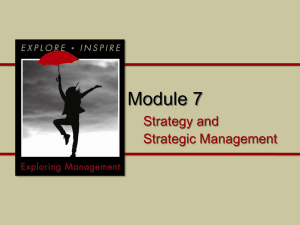
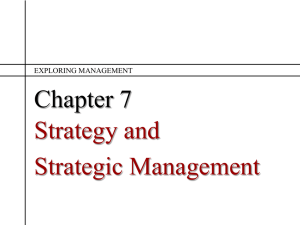

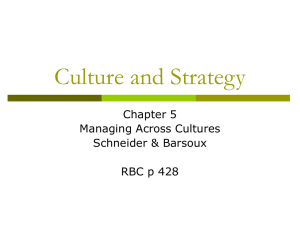
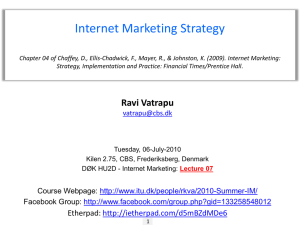
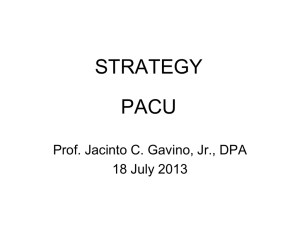
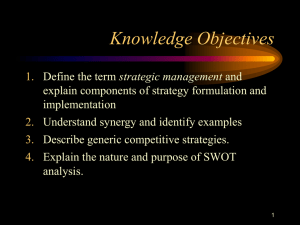
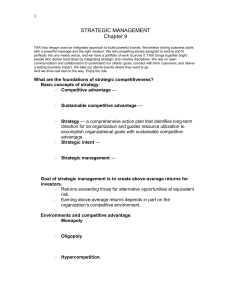

![[5] James William Porter The third member of the Kentucky trio was](http://s3.studylib.net/store/data/007720435_2-b7ae8b469a9e5e8e28988eb9f13b60e3-300x300.png)
